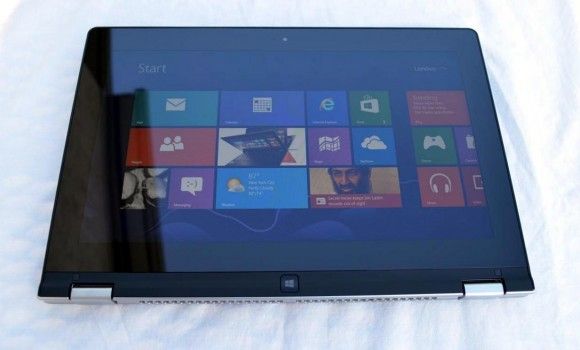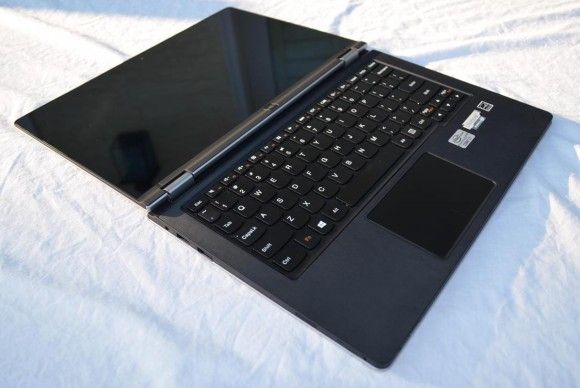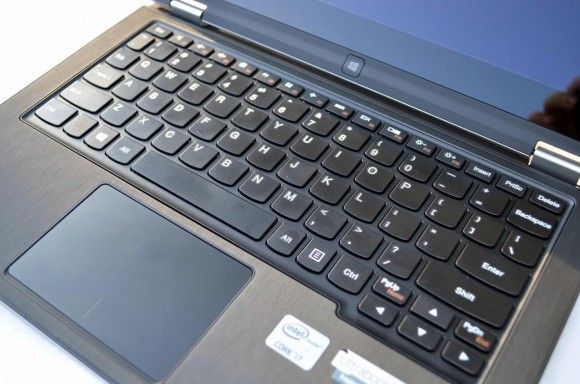Touchscreen / Display
The 11.6-inch touchscreen display has a fairly large bezel; a shame, because when the screen is off it often looks like the screen extends right to the edges thanks to an edge-to-edge piece of glass.
I’m not a stickler on large bezels, but I will say that 1366×768 resolution in the year 2013 is getting old, fast. Working with any sort of multimedia (video/photo editing especially) on such a low resolution feels very cramped. While 1080p is probably too dense for 11.6-inches (assuming we’re not doing any graphical scaling), 1600×900 should be a great fit.
Though it’s only 1366×768, the display uses IPS which gives it vibrant colors and and full viewing angles — a must for a convertible (which is likely to be in your lap and not facing directly at you). The viewing angles are great, but the contrast ratio is average for a laptop LCD (which is to say: not so great)
The touchscreen is as responsive as you’d expect from a capacitive multi-touch display (very!). The only time when clicks don’t go through right almost always end up being Windows’ fault. I should also mention there’s no capacitive digitizer on the Yoga S11.
A touchscreen is certainly a good augmentation when working with just the trackpad. I can now count myself among those who occasionally attempt to touch the screen on my non-touchscreen Ultrabook when I switch back to it. As for the Metro/touchscreen half of Windows 8, there’s not a whole lot on offer — I ended up spending most of my time with the desktop mode.
While all touchscreens are bound to get smudges from finger oil, it would seem that the Lenovo Yoga 11S’s display is particularly susceptible (perhaps the glass has poor lipophobicity?). It doesn’t normally affect usage, but occasionally, with the right light, you just have to stare in awe.
Keyboard and Trackpad
The keyboard on the Yoga 11S is great. The responsiveness and travel are superb, and it isn’t too noisy either. It may be that my hands fit it just right, but I’ve found the 11S’s keyboard to be one of my favorites of the many Ultrabooks that I’ve tested.
The F-key row sees all of the F-keys themselves relegated to use by the Fn key. Without using the Fn key, the row becomes host to a number of useful buttons like volume, brightness, airplane mode, etc.
On the F4 key, there is a square with an X in it. Looking similar to a ‘disable trackpad’ or ‘turn off backlight’ key, I pressed it to see what it would do, and it immediately closed the application I was working with. It’s literally a ‘close the window’ key, which I’ve never noticed on any other laptop. It makes a bit of sense because alt+F4 normally closes windows… but really it’s just a recipe for closing something important by accident and costing someone a lot of time!
My only concern with the keyboard is that there is some flex toward the middle. You hardly notice it when typing, but it’s sometimes a sign of poor build quality — not quite fitting with the rest of the Yoga 11S which is very solid. This issue is common on Lenovo IdeaPad laptops in my experience.
The tackpad is a plastic all-in-one as everyone seems to be doing these days. It works well for the most part and I didn’t have trouble with accidentally touching it and activating a click with my palms while typing. One annoyance is that if you try to do a two-finger scroll, but accidentally start where the virtual left and right buttons are, you will move the mouse instead of doing a scroll. If you aren’t careful you’ll be scrolling along fine when all of the sudden the mouse shoots to the top of the screen! The Yoga 11S is using the same Synaptics trackpad software as many other Ultrabooks, but I haven’t noticed this problem elsewhere. It could be that size and position of the trackpad lends itself to this behavior, or that I need to tweak some additional settings in the trackpad. That’s a fair enough excuse, but you’re typical day-to-day user really shouldn’t be expect to play with their trackpad settings in order to avoid such an annoyance.
While we’re on the topic: my recommendation is to always turn off pinch-zoom, rotate, and other gestures that are rarely used (and poorly implemented) in the desktop side of Windows 8. And definitely turn off the Edge Swipes, unless you want to be accidentally activating them all day on the desktop (it’s easy enough to use the touchscreen for this anyway). Don’t worry though, the same gestures won’t be disabled for the touchscreen half of Windows 8.
Continue reading on page 3…















Great review Ben. Let’s hope the price gets even better over the coming months.
For future reviews can you provide the following:
-WiFi chip and antenna configuration.
-Time graphs of WiFi data rate and latency over a long period.
-Time graphs of CPU frequency under prolonged load. If using cTDP then do this for each TDP setting.
Nice review. I guess the keys in tablet mode really are awkward. That close button seems unnecessary to me as well. I’m surprised Lenovo didn’t provide a groove for easier opening of the notebook.
Oh well, didn’t really think the whole yoga concept was good. Looks like it really isn’t that great after all.
This please. This review is even missing any information about WiFi and how much Turbo can be maintained. It’s as if the Yoga doesn’t have WiFi capabilities.
What WiFi configuration(s) does this have? It’s completely missing from the review.
One question: how is the Ivy-Bridge-Y (I7) compared to AMD’s Temash A6 ?
tried the 11S at BestBuy yesterday. i’m not sure if its just the demo i used, but when in tablet mode, keypress are still registered. isnt it suppose to disable the keyboard when in tablet mode?
Yes it’s definitely supposed to disable the keys — worked perfectly on the unit I used.
40% faster in worst case, and 2.5x+ faster in best case in favor of the Ivy Bridge Y. The Ivy Bridge will get 2x or more gains in scenarios that are lightly threaded, which you will find it to be the case in vast majority of usages.
It’s probably worth mentioning that both the Yoga 13 and Yoga 11S uses single-channel memory. That will hamper the CPU performance a bit and GPU performance quite a bit.
What kind of real world FPS drop for a particular game you know of would a single-channel memory have vs dual-channel? Benchmark number differences usually can’t be easily converted to any kind of FPS differences. Sometimes a large benchmark score difference didn’t have much impact on actual FPS.
I don’t know why anyone takes any unit with a 1366×768 display seriously today, or how PC makers keep getting away with marketing inferior products. Seriously, Google can release a $229 quad core tablet with a 1920×1200 display, 2gb ram, 16gb ssd… and yet PC makers keep releasing $700+ notebooks and tablets with 1366×768 displays.
I’m guessing 20-40% depending on games for the single channel versus dual channel. That would get progressively worse on higher resolutions and settings. That was for the HD 3000, a better performer like the HD 4000 would probably end up little bit worse.
Cinebench GL rendering is actually not very sensitive to memory bandwidth, and neither are the 3DMark benches tested here.
Actually that quad core chip is weaker than AMD E-350 chips on the PC. Using 2GB RAM and 16GB SSD will also save on the money. 4GB vs 2GB RAM would be responsible for about $50 of the cost and 16GB “SSD”(actually a very low throughput eMMC controller) another $150 or so. If you go for the Intel Atom or AMD E series chips you’ll save another $150.
-Then add in margins PC makers require, versus Tablet vendors like Google often close to losing money on the hardware so they can sell apps
-PC makers have too many models, so they are disadvantaged on the volume discount
You will see the resolution disparity quickly close in the next few years. Right now the effort to push 1800p and above displays on the premium will trickle down so you’ll get 1080p in cheap Laptops for example.
I know there are differences in performance, etc. etc. but if you can put a screen in excess of 1080p in a budget tablet and still get good battery life then the arguments for 1366×768 displays just don’t hold water.
At this point I think anything larger than an 11.6″ should at least have 1600×900 displays. I like the 11S but its display completely discounts it as an option for my use.
What’s your use case where the lower resolution would noticeably impact your particular task?
For me, I care more about power consumption, brightness, contrast, viewing angles and glare than high PPI especially on a desktop OS where high PPI causes UI issues. Even setting the DPI scaling causes additional problems.
Its a little heavy for an 11″ device, resolution a little low and I don’t like sagging keyboards.
Lenovo, please don’t let your keyboards slide…